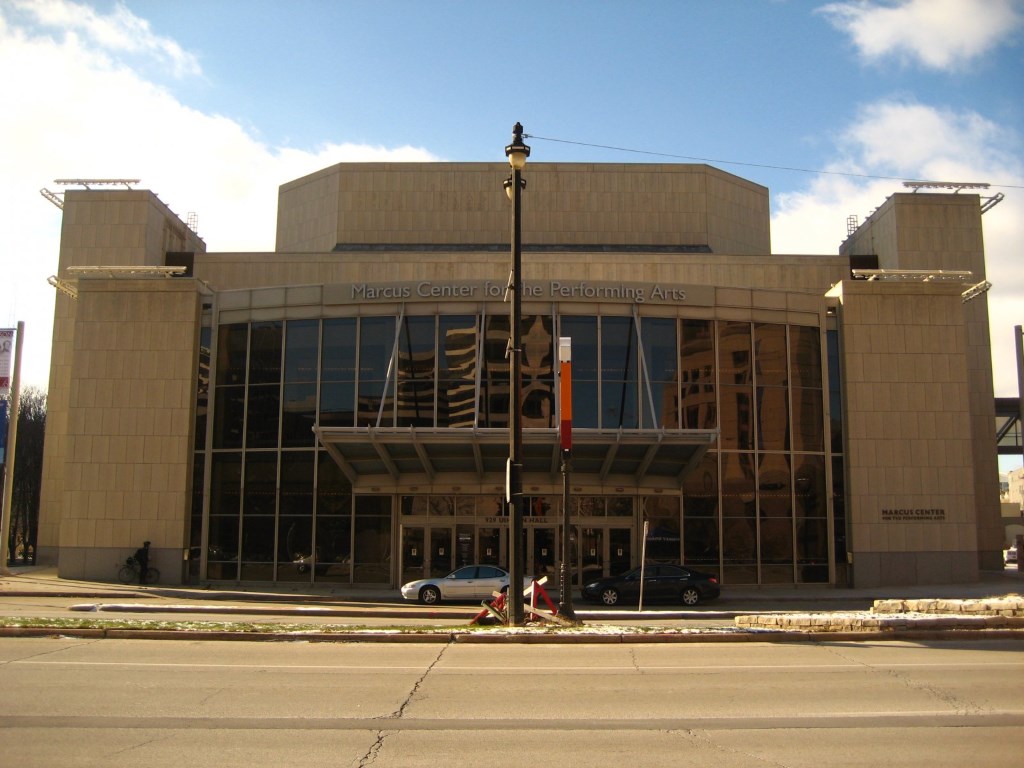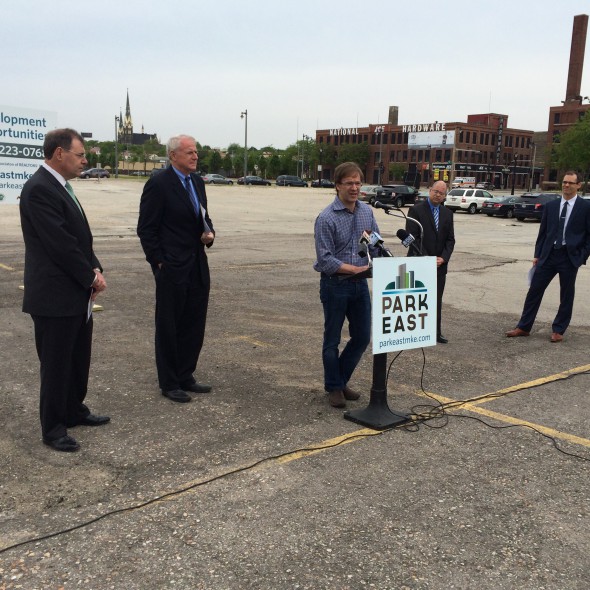What Will WCD Board Do About Marcus Center?
Abele wants them to take over arts center but WCD board members would rather wait till 2020.
Who do you know who wants to take over an arts center? Last summer, Milwaukee County Executive Chris Abele succeeded in getting state legislation passed which calls for the Wisconsin Center District (WCD) to take over the Marcus Center for the Performing Arts. But as Urban Milwaukee has reported, no one is very excited about the idea: Milwaukee County Board members, WCD board members and Marcus Center leader Paul Mathews have all expressed misgivings. And WCD board members have indicated they are in no hurry to take ownership of the Marcus Center.
As the Business Journal reported, WCD board members have said they’d rather wait till 2020 to transfer ownership of the arts center, but Abele wrote a letter to the board saying 2020 is too late and proposing that a joint operations committee be created to study and implement operational improvements, revenue opportunities and limiting duplicate expenditures among the Wisconsin Center, Marcus Center and Visit Milwaukee. Abele proposes the committee consists of three board members each from the Wisconsin Center District, Visit Milwaukee and the Marcus Center for the Performing Arts.
Such analysis and planning is more typically done before committing to a merger, not after. For example, committees are currently assessing pros and cons regarding possibly merging the state’s public technical and two-year colleges.
The WCD already oversees the Wisconsin Center convention hall, UWM Panther Arena, and Milwaukee Theatre and provides funding for Visit Milwaukee. But the state legislation approving a new NBA arena also gave the WCD oversight of the new arena. The Marcus Center has four theaters and other facilities within its waterfront complex just east of the Milwaukee River, which add more complexity for the WCD.
Taking all this on would be a new 17-member board of directors whose chairman is state Department of Administration Secretary Scott Neitzel, and includes representation of the state Legislature’s four majority and minority leaders plus the city comptroller. They are reluctant at this juncture to sort through the logistics and ramifications of acquiring the Marcus Center because they already have a full plate with oversight of arena construction plans and other issues. Before the Marcus could be annexed, myriad management and governance issues would need to be hammered out.
The law calls for the WCD to acquire the Marcus Center “as soon as practicable” and without any financial encumbrance — neither of which is defined. Which seems to mean both sides could be right: the WCD could say its currently not “practicable” to take over the art center while Abele could accuse them of stalling.
In the spirit of Abele’s call for a joint operations committee involving the various downtown players affected by this issue, we thought it might be helpful to lay out some of the potential issues and describe in detail the various entities involved in any merger. Among the issues:
-The Public Policy Forum identified about $37 million in capital needs for the Marcus Center. Who will pay for this? It’s presumed that the term “unencumbered’ in the state legislation means without debt, but does it also mean without major outstanding repairs? (For insurance purposes, the Marcus Center is reportedly valued at $77 million dollars; the tax-exempt complex does not have an assessed or known appraised value.)
-Can any money can be saved on staff or overhead by bringing the Marcus Center under the oversight of the WCD? Several civic leaders, including Discovery World CEO Joel Brennan, who serves on the boards of the Marcus Center and the WCD, have stated that collaboration and high efficiency can be achieved without merging institutions.
-Would the Marcus Center’s 25-person board, which currently consists of mostly civic leaders, be disbanded? That could mean the loss of a deep bench of members dedicated to the performing arts. How would the Marcus Center’s significant private fund-raising be impacted ($1.1 million raised in 2014) if it loses that board?
-What would become of the Marcus Center for the Performing Arts, Inc., a nonprofit corporation with a $12.2 million budget in 2014? Will the Marcus Center’s commitment to providing free and affordable programming for diverse populations be watered down if its public support gets reduced or nixed?
-Who will represent the concerns of the Marcus Center’s six resident companies, including the Milwaukee Symphony Orchestra, Milwaukee Ballet, Florentine Opera, First Stage Children’s Theater and Hansberry-Sands Theater?
-County board members have indicated an unwillingness to continue funding the Marcus Center if the county loses control of the center; that subsidy was $900,000 for 2016, down from $1.1 million in 2014. Can board members be convinced to continue that funding and, if not, will the WCD provide the funding?
-Independently of the county, the Marcus Center also owns an adjacent parking structure, which would not be part of any transfer to the WCD. The Marcus Center’s current leadership wants to replace the deteriorating structure with a taller, mixed-use facility with potential for greater revenue, including a restaurant. What will happen to these plans if governance of the Marcus Center is transferred?
-The Metropolitan Milwaukee Chamber of Commerce recently also announced its intent to explore options for dedicated funding for cultural institutions in the county. Would a state-owned Marcus Center still be in line for such funding?
-One big obstacle to achieving a harmonious marriage between these entities could simply be the disparities between the missions, audiences, and uses of Marcus Center and current Wisconsin Center District venues (outlined below). Compatibility matters in successful partnerships. Sports events, conventions and large-scale exhibitions require different marketing than cultural offerings and community-oriented programming. Can the same management oversee all that?
And here are the major players involved, who would all fall under one central management:
Marcus Center for the Performing Arts (A multi-venue complex) Opened: 1969
- Operating Budget: $12.2 million (2014)
- Ownership (performing arts complex): Milwaukee County
- Ownership (parking structure): Marcus Center for the Performing Arts, Inc. (built on land leased from the City of Milwaukee)
- Governance: The 25-person board of directors has seven members appointed by the Milwaukee County Executive. Those appointments must be approved by the Milwaukee County Board of Supervisors.
- Management: Marcus Center for the Performing Arts, Inc., a nonprofit corporation
- Seats: Uihlein Hall, 2,305; Todd Weir Hall, 496; Wilson Theater at Vogel Hall, 475; open-air Peck Pavilion, 400 (for free performances); variable seating at KidZ Stage and Fitch Garden (outdoors) and Bradley Pavilion and Green Hall, banquet halls
- Leases: Resident companies hold leases
- Exclusive Caterer: Sazama’s Fine Catering
- Uses: Home of the Milwaukee Symphony Orchestra and Milwaukee Youth Symphony, Milwaukee Ballet Company, Florentine Opera, First Stage Children’s Theater, Black Arts Think Tank and Hansberry-Sands Theatre. Hosts Broadway touring company productions; concerts; conferences, meetings, community events including free performances; weddings, receptions, banquets.
- Public Subsidy: $900,000 annually from Milwaukee County
- Other Funding: Private sponsorships and donations
Wisconsin Center District Facilities:
Wisconsin Center (convention hall); opened: 1998
- Capacity:3,150 in the ballroom; 266,000 square feet of convention space
- Uses: Conventions, trade shows, exhibitions; catered special events
UWM Panther Arena (opened in 1950 as the Milwaukee Arena, renamed in 2014 under a 10-year sponsorship contract)
- Seats: 10,783 (basketball); 12,700 maximum
- Uses: Leased to UW-Milwaukee for basketball and other events; home of Milwaukee Wave (Major Arena Soccer League), Brewcity Bruisers (roller derby); convention and exhibition events. Expected to become home of International Hockey League Milwaukee Admirals in 2018.
Milwaukee Theatre opened as the Milwaukee Auditorium in 1909; renovated and reopened as a theater in 2003
- Seats: 4,086 (or 2,500 reconfigured)
- Uses: Concerts and performing arts events; convention, corporate, religious and political assemblies
New Bucks Arena will be added to the WCD portfolio, with separate management and profits going to the Milwaukee Bucks, which will have a 30-year management lease and receive all revenues. Expected lifespan is 30 years.
- Proposed Seats: 17,000
- Planned Uses: Milwaukee Bucks and Marquette University basketball; concerts and other events
Wisconsin Center District Operations
- Operating Budget: $29.6 million (2014)
- Ownership: Wisconsin Center District, a state-chartered semi-autonomous municipality
- Governance: WCD’s 17-member board is appointed by city, county and state elected officials and meetings are open to the public.
- Management: Wisconsin Center District, Inc. will continue to manage three existing WCD properties; the Bucks will manage the new arena as a for-profit operation under a lease executed by the state’s director of administration and overseen by the WCD board.
- Exclusive Caterer: Levy Restaurants
- Employees: About 285 (full-time and part-time)
- Public Subsidies: The WCD receives hospitality taxes (hotel, rental car and food-and-beverage) that are used only to repay construction debt and to fund Visit Milwaukee tourism promotion. After construction debt is repaid in about 13 years, those taxes will begin to repay WCD debt for Bucks Arena ($93 million).
- The Bucks Arena will receive $250 million in cash subsidies from city, county, state and WCD taxation (plus interest), nine acres of free public land for the arena, and other tax breaks. The Bucks owners will be ceded about 21 more acres for private development and given a city-owned parking structure built for $30 million to be razed for a for-profit entertainment mall.
- Additional Funding: Sponsorships and advertising; Bucks will retain all Arena-related revenue, including naming rights and other sponsorship. Ticket surcharge income will be used to offset some taxpayer borrowing.
The BMO Harris Bradley Center has not been connected with the WCD. It’s profiled here for comparison between how it has operated and plans for the new arena.
BMO Harris Bradley Center (Sports and entertainment arena) Opened: 1988
- Ownership: Bradley Center Corporation, Inc., a state-chartered not-for-profit corporation
- Governance: A nine-person board appointed by the governor, including two minority owners of the Bucks. Meetings are not open to the public but may be covered by media.
- Management: Bradley Center Corporation, Inc., which will be dissolved after the new Milwaukee Bucks Arena is completed. Bucks owners must raze the arena and public parking garage on 6th Street after the new arena opens; the land will be ceded to the Milwaukee Bucks for private redevelopment.
- Seats: 18,700 (basketball); 20,000 (concerts)
- Leases: Primary leaseholder is Milwaukee Bucks, with a no-rent lease and shares of all revenue (about 41% of overall revenue in 2014). Marquette University and Milwaukee Admirals pay rent through lease agreements.
- Uses: Bucks and Marquette University basketball, Admirals minor-league hockey; major concerts
- Revenue: Marquette and Admirals leases; percentage of luxury suites and concessions after Bucks commissions; sponsorships, ticket surcharges
- Public Subsidies: $10 million in state funding since 2006; $175,000 annually from City of Milwaukee
- Other Funding: Sponsorships and naming rights
- Debt: About $20 million, to be covered by state taxpayers



















This is the prime reason that the new arena should have been placed at the site of the often empty, Milwaukee Theater and basically obsolete UWM Panther Arena (how’s that sponsorship look now with the UW budget cuts?). The Marcus Center has compelling useful programming while the Theater is rarely used. There are too many venues that sit empty. ALSO, that placement would have worked in concert with a new Wisconsin Center expansion and the downtown plan for Kilbourn Ave.
Jeremy,
“Obsolete” is a relative term. UWM officials have been very vocal about how happy they are about their lease arrangement and sponsorship of the UWM Panther arena–and protective of it:
http://www.jsonline.com/news/milwaukee/school-leaders-not-happy-with-talk-of-tearing-down-uw-milwaukee-panther-arena-b99368971z1-278961801.html
Excerpt:
“Eager to broaden its reach beyond its tightly compacted east side campus, UWM has been branching out — in downtown Milwaukee through its School of Continuing Education and the Zilber School of Public Health, in Wauwatosa through its Innovation Accelerator, and on the lakefront through its School of Freshwater Sciences.
“We love being in the heart of downtown,” Mone said.
The long-term commitment to the UWM Arena was the next big step. Announced in June, the agreement with the Wisconsin Center District is valued at $3.4 million. As part of the agreement, UWM is being given extensive arena signage and will have a presence on the new scoreboard inside. Just as important, university officials say, UWM will be given booking priority for university-related programming over the 10-year period.
“We have found a perfect solution for our needs,” added Michael Laliberte, vice chancellor for student affairs. “And I think there is a perfect solution for the (Milwaukee) Bucks’ needs and the rest of the city as well. “Our presence downtown is incredibly important. We know that every single person using that space will see our name on the board, on tickets. It’s going to feel like the rest of our campus. We would lose that opportunity.”
As for the UW budget cuts and that sponsorship, $3.4 million to use this arena for games and commencements and such for 10 years costs them much less than what it would have to build new, and that option surely would have hit roadblocks in this climate.
Brimming with righteous indignation, the Smalls once again fail to contribute anything worthwhile to the discussion. Keep digging that hole!
Jeremy must be misinformed. The theatre and the arena have many more events than people realize because they’re not public/ticketed (from graduations to corporate meetings to MPD training sessions).Milwaukee Theatre is the only venue able to host the touring production of “The Lion King” and did so as recently as last November. Word on the street is that the Admirals will move to a place that will show them the proper respect as soon as possible.
I do not agree
http://www.bizjournals.com/milwaukee/news/2015/11/20/wisconsin-center-district-board-not-eager-to-take.html
Sona